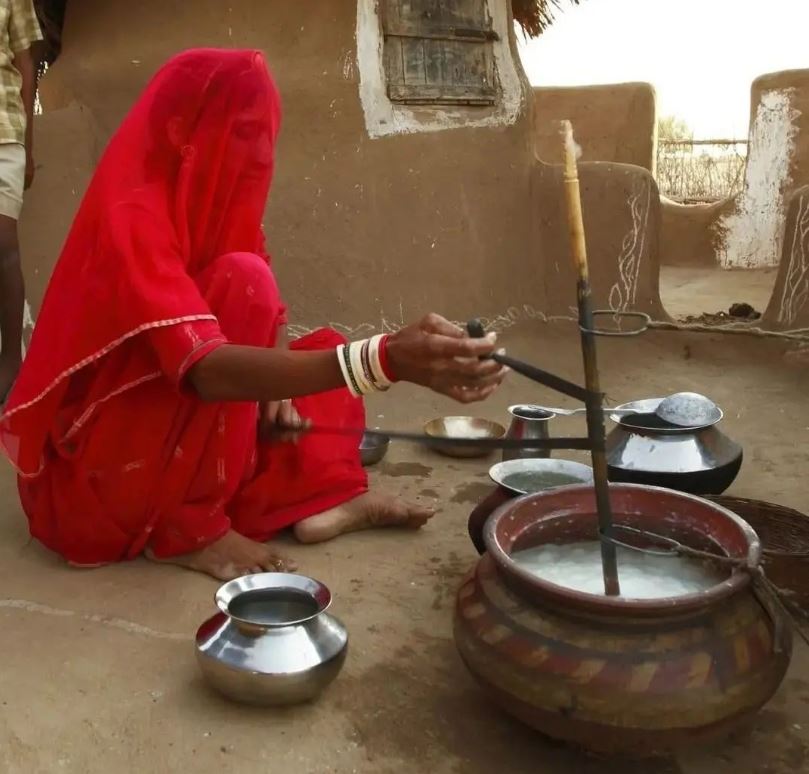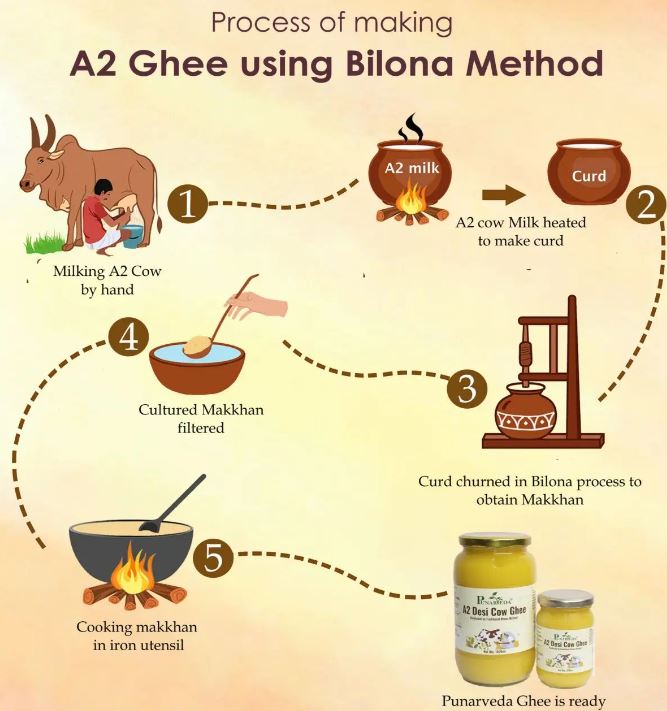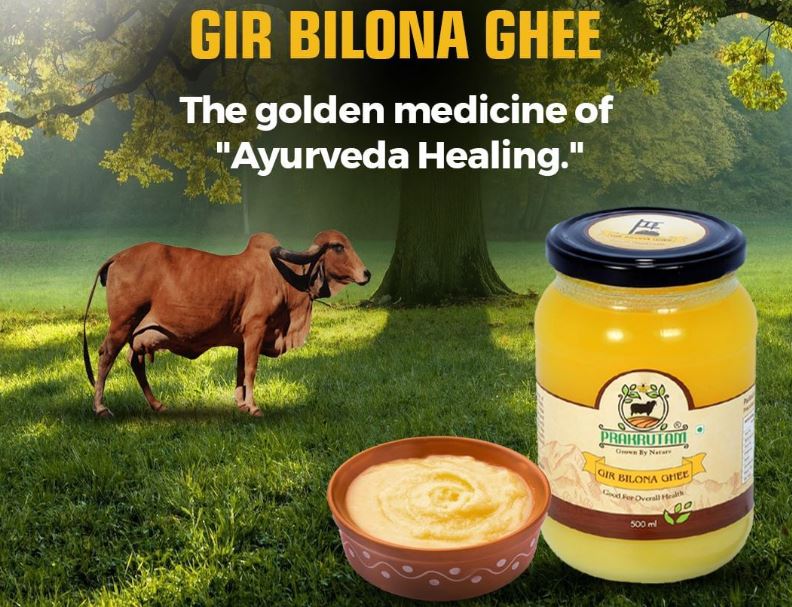Bilona Ghee is the Purest Form of Desi Ghee made from Wooden Beater in a Traditional Way. ‘Bilona’ has been used from the ancient times to churn out butter from the curd. You might have seen your Grandma using it. Desi Ghee made using Bilona have better Taste, Aroma and Nutrition compared to processed Ghee. Here’s Bilona Ghee Wikipedia, Everything you Need to know about Desi Organic Bilona Ghee, Gir Cow A2 Ghee, Making Method, Ayurvedic Benefits of Eating Bilona Ghee, Price and more.

“Bilona” is a term commonly used in India to refer to the traditional method of making ghee (clarified butter) from milk. The process involves boiling the milk and then churning it to separate the cream, which is then further processed to obtain ghee.
In this method, the milk is typically boiled in a clay pot (called a “matka” or “kadhai”) over a wood-fired stove, and then left to cool. The cream rises to the top, and is then collected and churned using a wooden tool (called a “mathni”) until it forms butter. The butter is then heated to separate the ghee, which is a clear, golden liquid that is used in cooking, as a condiment, and in various traditional Ayurvedic remedies.
Bilona ghee is highly valued for its rich, creamy flavor and aroma, and is considered to be of superior quality compared to commercially produced ghee.
Bilona Ghee Making Method
The traditional method of making ghee using a bilona involves the following steps:

- Boil Milk: Start by boiling milk in a large, heavy-bottomed pot over medium heat. The milk should be heated until it begins to boil, at which point you can reduce the heat to low and let it simmer.
- Churn the Milk: Once the milk has cooled, use a hand-cranked or motorized churner (mathni) to agitate the milk until it begins to separate into butter and buttermilk. The churning process can take anywhere from 10 to 30 minutes, depending on the amount of milk being processed and the speed of the churner.
- Melt the Butter: Once the butter has been separated from the buttermilk, transfer it to a heavy-bottomed pot or a traditional clay pot (matka or kadhai) and heat it over low heat. The butter will begin to melt, and the solids will begin to sink to the bottom of the pot.
- Skim Off the Foam: As the butter continues to cook, a foam will form on the surface. Use a spoon or a ladle to skim off the foam, and continue cooking the ghee until it is clear and golden in color.
- Strain the Ghee: Once the ghee is ready, carefully strain it through a cheesecloth or fine mesh strainer to remove any solids. Let the ghee cool completely, and then transfer it to a clean, airtight container.
Note: It is important to monitor the temperature of the ghee while it is cooking, as overheating can cause it to burn and spoil the flavor. Additionally, be sure to use high-quality milk and butter to ensure the best results.
What is A2 Bilona Ghee –
A2 Bilona ghee is a type of ghee made using the traditional Bilona method, but using only A2 milk. This means that the milk used to make the ghee is sourced from cows that produce A2 beta-casein protein, which is believed to be easier to digest and less likely to cause digestive discomfort compared to the A1 beta-casein protein found in most cow’s milk.
A2 Bilona ghee is typically made by boiling the milk, separating the cream, and then churning it to make butter. The butter is then melted and simmered until the solids settle to the bottom, and the clear golden liquid is strained to produce the ghee.
Like other types of A2 ghee, A2 Bilona ghee is often considered to be a healthier alternative to regular ghee, and is believed by some to be better for individuals who are sensitive to dairy or who have digestive issues. However, the scientific evidence supporting these claims is limited and more research is needed to fully understand the health benefits of A2 ghee. As with any food product, it is always best to consult with a healthcare professional before making any changes to your diet.
Why Gir Cow A2 Ghee is Better?
Gir cow A2 ghee is a type of ghee made using milk from Gir cows, which are a breed of dairy cattle native to India. Gir cows are known for producing milk that contains high levels of A2 beta-casein protein, which is considered to be easier to digest and less likely to cause digestive discomfort compared to the A1 beta-casein protein found in most cow’s milk.

Some people choose to use Gir cow A2 ghee because they believe that it is a healthier alternative to regular ghee, and that it may offer a range of health benefits, such as:
- Improved digestion: A2 beta-casein protein is believed to be easier to digest and less likely to cause digestive discomfort compared to A1 beta-casein protein, making Gir cow A2 ghee a good option for individuals with digestive sensitivities.
- Increased nutrient absorption: Some proponents of Gir cow A2 ghee claim that it is a better source of essential fatty acids and other nutrients compared to regular ghee, which can help to improve nutrient absorption and support overall health.
- Traditional Ayurvedic use: Gir cow A2 ghee is often used in traditional Ayurvedic cooking and remedies, and is believed to offer a range of health benefits when used in this way.
Ayurveda Benefits of Bilona Ghee –
Bilona ghee, which is traditionally made using the Bilona method, is highly valued in Ayurvedic medicine for its potential health benefits. Some of the potential benefits of Bilona ghee include:
- Improved digestion: Bilona ghee is believed to help improve digestion by lubricating the digestive tract and promoting the release of digestive enzymes.
- Boosted immunity: Bilona ghee is thought to have immune-boosting properties and to help strengthen the body’s natural defense mechanisms against illness and disease.
- Anti-inflammatory effects: Some proponents of Ayurvedic medicine believe that Bilona ghee has anti-inflammatory properties that can help to reduce pain, swelling, and other symptoms associated with conditions such as arthritis and other inflammatory disorders.
- Better skin health: Bilona ghee is thought to help improve skin health by providing the skin with essential fatty acids, vitamins, and minerals that can help to reduce dryness, improve texture, and promote a youthful appearance.
- Better brain function: Some Ayurvedic practitioners believe that Bilona ghee can help to improve cognitive function, memory, and overall brain health.
Bilona Ghee Price –
The price of Bilona ghee can vary depending on a number of factors, including the region where it is purchased, the brand, and the quality of the ghee. In general, Bilona ghee is considered to be a premium product and can be more expensive compared to regular ghee.
On average, the price of Bilona ghee can range from INR 500 to INR 1,500 or more for a 500-gram jar, depending on the brand and the quality of the ghee.
It is important to note that while a higher price tag does not always indicate higher quality, it is still a good idea to carefully research and compare different brands of Bilona ghee to find the one that offers the best value for your money. In addition, it is always a good idea to look for ghee made using pure, high-quality ingredients to ensure that you are getting the best possible product.
bilona ghee
bilona ghee making method
bilona ghee price
bilona ghee means
a2 bilona ghee
bilona ghee cow
a2 cow ghee bilona method
vedic bilona ghee
bilona ghee benefits
bilona ghee process
bilona ghee making machine
girorganic a2 pure ghee
bilona method of making ghee
